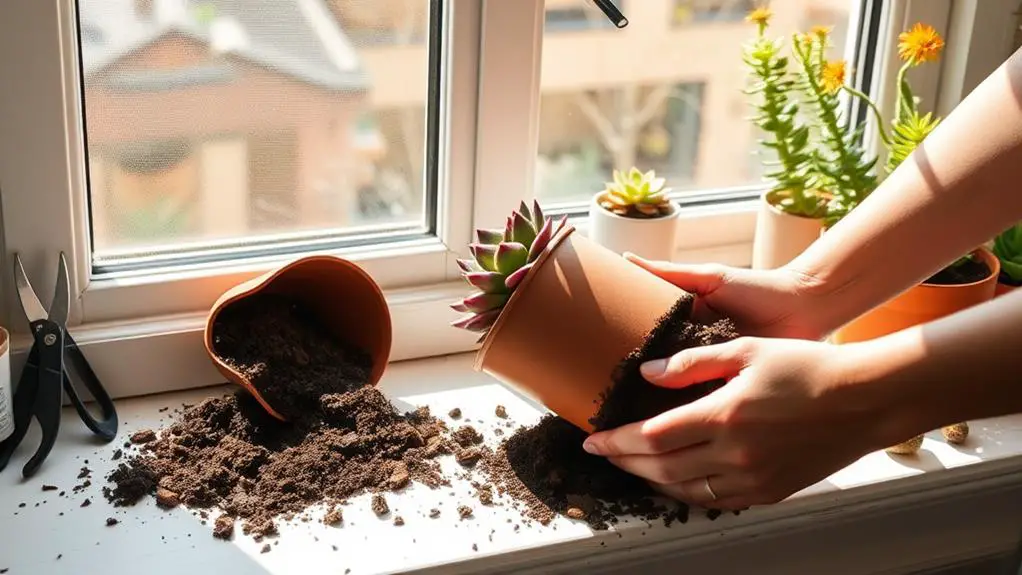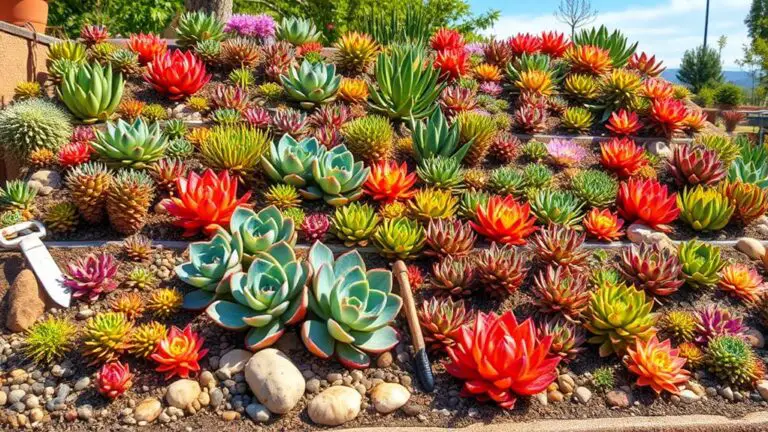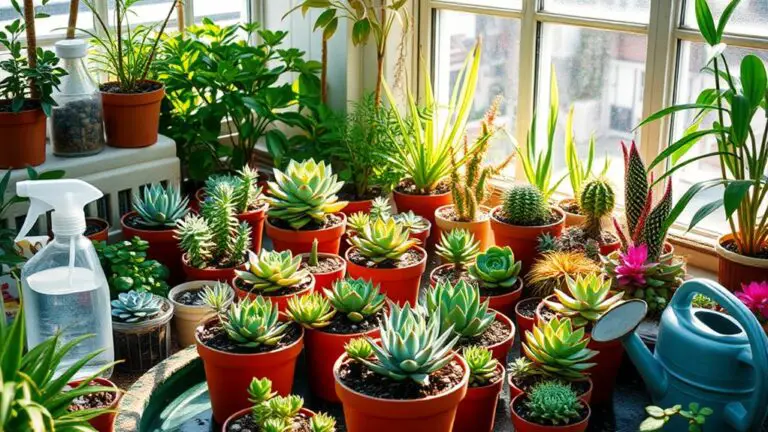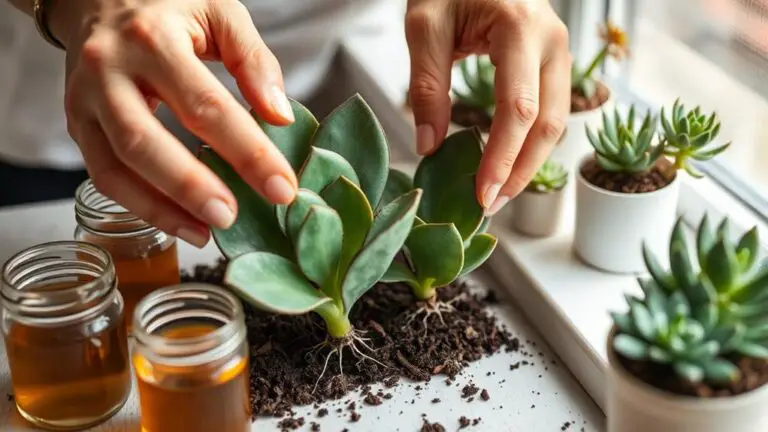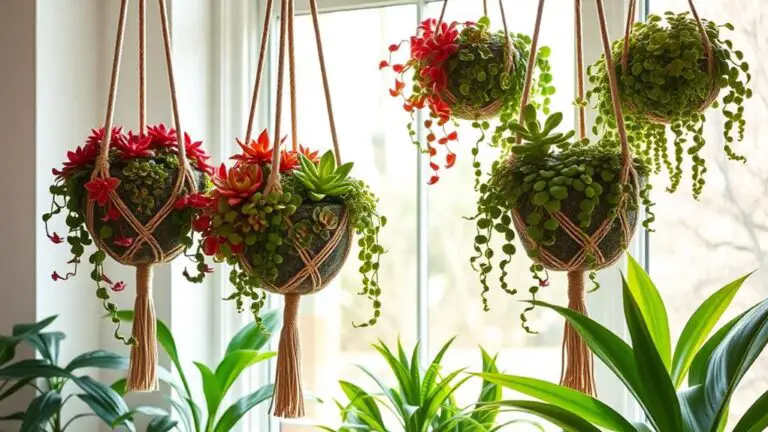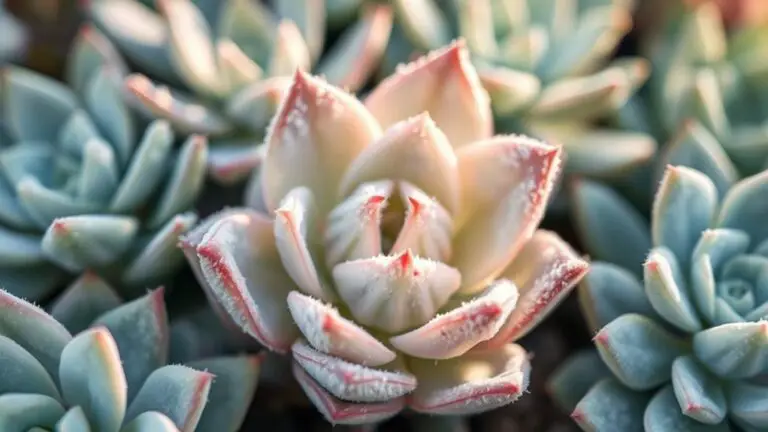Spilled Succulents Aren’t a Disaster: Replant and Revive
When your succulent takes an unexpected tumble, it's easy to feel like you've lost a beloved plant. However, this mishap isn't the end; it's actually a start for something new. By examining the roots and trimming away any unhealthy parts, you can prepare your succulent for a fresh beginning. Letting the cut ends dry before replanting in well-draining soil guarantees a healthier future. You'll discover that this process not only salvages your plant but also opens up opportunities for propagation and new growth. Curious about how to turn a spill into a thriving garden? Let's explore these steps together.
Propagation Opportunities
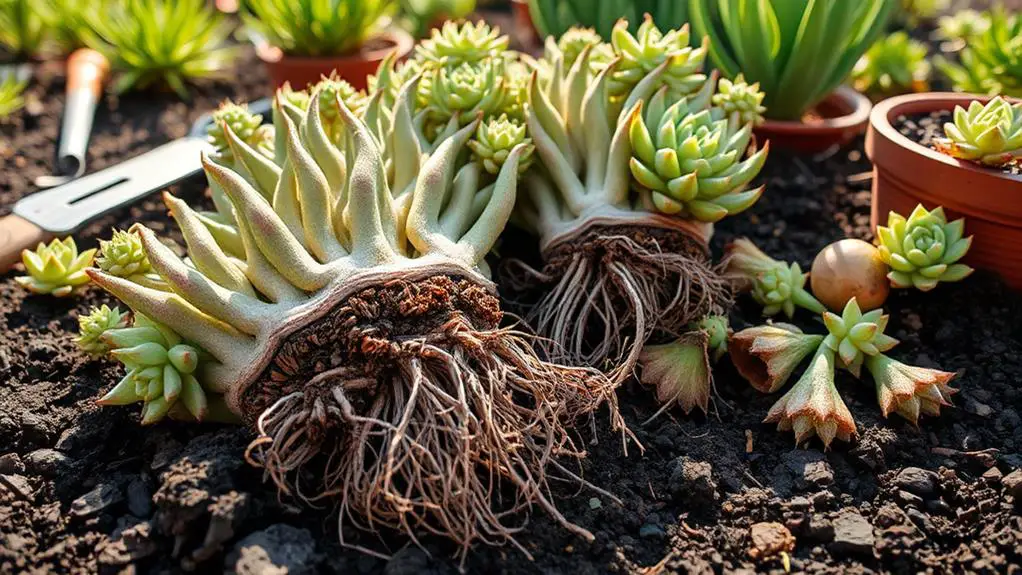
Propagating succulents offers exciting opportunities to expand your plant collection without much effort. Many succulents can easily propagate from leaves, turning broken or knocked-off pieces into new plants. It's a simple process that can yield great results with minimal work. Just make sure to follow a few essential steps.
First, when you have a fallen leaf, let the end dry out for a few days. This prevents rot, which is a common issue if planted too soon. Once the leaf end is dry, it's ready to be placed on soil. Some succulent varieties are exceptionally good at this and can even grow new plants from broken leaf remnants.
Here are some tips to help you succeed: use well-draining soil, provide indirect sunlight, and water sparingly. Succulents don't need much water, so don't overdo it.
Patience is key, as it might take a few weeks for roots and new leaves to appear.
Taking advantage of fallen leaves for propagation maximizes your efforts and turns accidents into opportunities. Successfully propagating succulents can lead to a richer, more diverse collection, giving you the satisfaction of growing new plants from what seemed like a mishap.
Root Examination
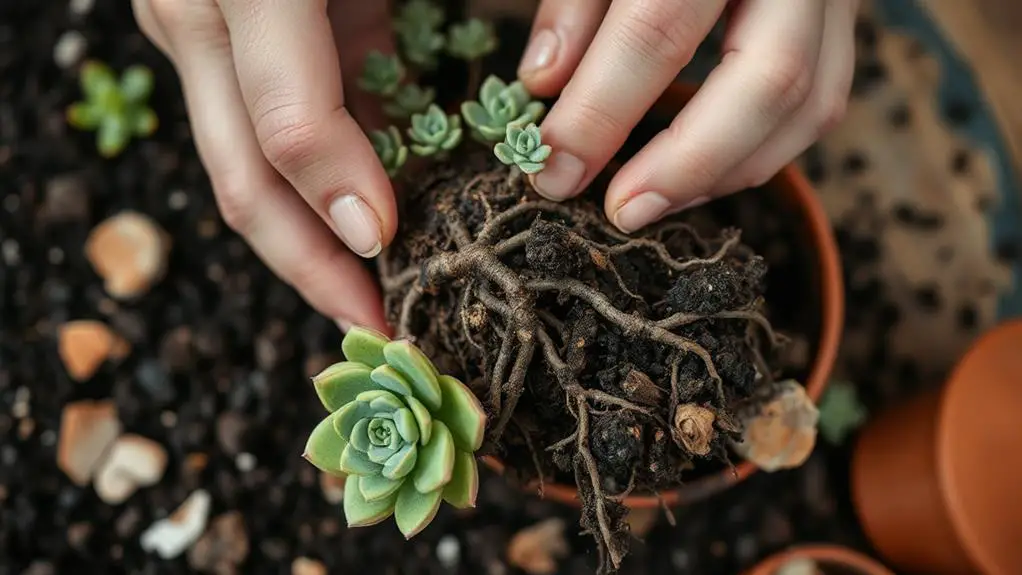
When your succulent falls, it's a great chance to check its roots and see how healthy they are.
Healthy roots should be firm and white, while mushy ones mean trouble like overwatering.
Identifying Healthy Roots
Examining the roots of your succulents is essential for ensuring their overall health and longevity. Healthy roots should appear firm and white, showing that your plant is on the right track to grow well year-round. When your succulent falls, it's a great chance to check the roots without disturbing a healthy plant.
Here's a quick guide on what to look for:
| Root Condition | What It Means |
|---|---|
| Firm and White | Healthy, well-cared-for |
| Mushy or Black | Overwatered or rotting |
| Brown and Dry | Underwatered or damaged |
Healthy roots are your succulent's lifeline. If they're firm and white, you're doing everything right. But if they're mushy or discolored, it's time to take action. These signs often point to overwatering or root rot, which needs immediate attention.
Regular root checks are key. They help you spot issues early and adjust your watering practices accordingly. After repotting, give your succulent 1-2 days to heal before watering again. This little break helps the roots recover, preventing rot.
Signs of Overwatering
Overwatering is one of the most common issues that can jeopardize the health of your succulents. When you suspect overwatering, examining the roots is essential. Healthy roots should be firm and white, indicating proper care. If the roots are mushy, it's a clear sign of overwatering. Regularly inspecting roots during repotting or after a plant falls can help you identify issues early.
Here's what to look for:
- Firm and White Roots: Healthy roots should be firm and white. If they aren't, you might be overwatering.
- Mushy or Blackened Roots: Mushy roots usually mean rot due to too much water. Blackened roots also indicate severe damage.
- Yellowing Leaves: This can be a sign of root distress or rot. If you spot yellow leaves, check the roots immediately.
- Dry Soil Between Waterings: Make sure the soil dries out completely before watering again. This helps prevent overwatering issues.
If you find any blackened or rotting roots, trim away the affected areas to encourage healthy regrowth.
Always remember, succulents prefer dry conditions. Allowing the soil to dry out between waterings is vital for maintaining healthy roots.
Root Health Indicators
Evaluating root health is essential for maintaining the vigor of your succulents. When you check the roots, look for ones that are firm, white, and free from mushiness. These signs indicate that your succulent is getting the right amount of water and care. You don't always need to uproot the plant if it looks healthy; a visual inspection is often enough to guarantee the roots are in good shape.
However, if your succulent has fallen over, it's an excellent chance to examine the roots more closely. This can help you decide if repotting or extra care is needed. Roots that are brown or mushy usually mean the plant has been overwatered and might be starting to rot. If you notice this, you should act quickly to save your plant.
Regularly checking on your succulent's roots helps you keep the plant healthy and adjust your watering practices if needed. By focusing on root health, you can prevent future problems and guarantee your succulent thrives.
Baby Succulents
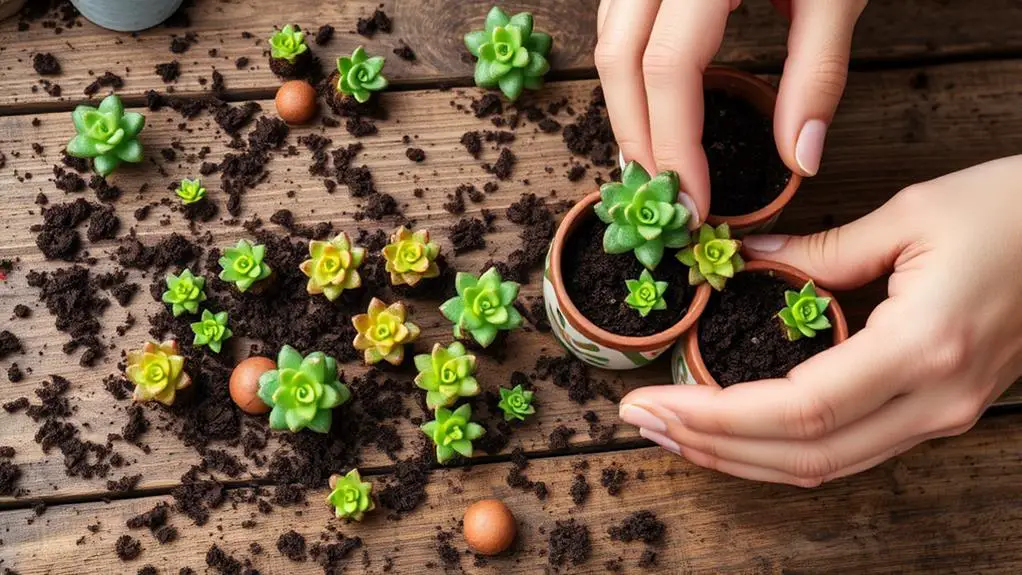
When it comes to replanting baby succulents, the process can be both rewarding and straightforward. These young plants, often called offsets or pups, can be separated from the main plant once they've developed a few roots of their own. This usually happens after a few weeks of growth.
To guarantee success, follow these steps:
- Remove the Offsets: Carefully separate the baby succulents from the main plant. Make sure they've a few roots before doing this.
- Dry the Cut Ends: Let the cut ends of the baby succulents dry out for a day or two. This helps prevent rot and promotes root establishment.
- Replant in Well-Draining Soil: Use a pot with drainage holes and fill it with well-draining soil. This is essential to avoid overwatering.
- Monitor and Care: Keep an eye on your baby succulents. Provide adequate sunlight and airflow to help them thrive as independent plants.
Pruning for Shape

Pruning succulents not only helps you manage their shape and appearance but also promotes healthier and more vigorous growth. When your succulent looks lopsided due to broken pieces, pruning can correct this imbalance and encourage a more uniform shape.
Regular pruning also stimulates new branch growth, which leads to a fuller, healthier plant.
To get started, make certain you use clean, sharp tools. This minimizes stress and damage to your succulent, helping it recover more quickly. You should prune during the growing season for the best results. This timing guarantees that your succulent has the energy it needs to heal and grow new branches.
When you prune, don't just toss those cuttings away! They can be replanted to propagate additional succulents.
Repotting Guidelines
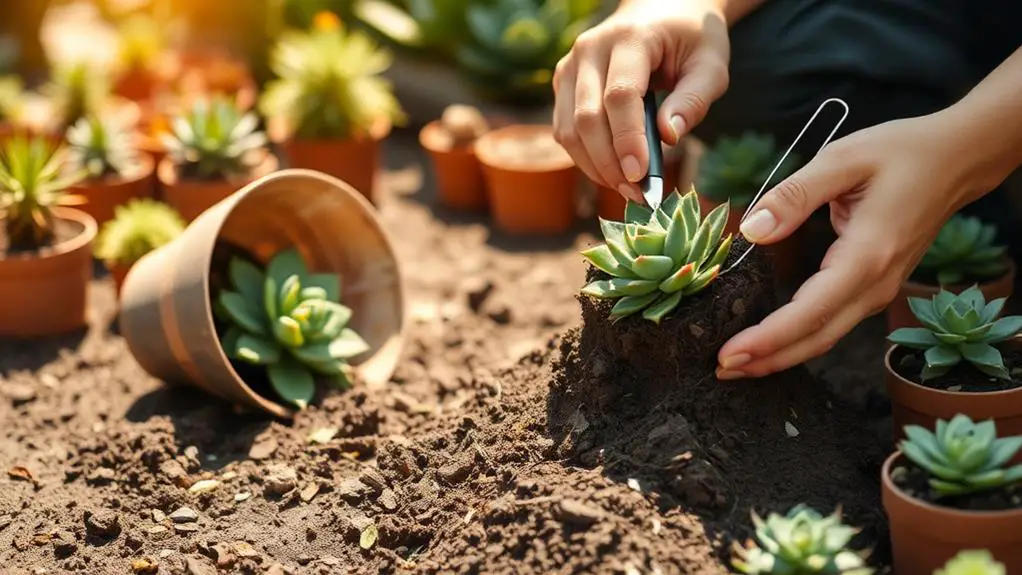
Repotting your succulents might seem challenging, but it's vital for their health and growth. To guarantee a smooth process, follow these key steps:
- Remove the Plant Gently: Carefully take the succulent out of its current pot. Handle the roots with care to avoid damage. It's important to be gentle to keep the roots healthy.
- Use Well-Draining Soil: Choose soil specifically designed for succulents. This type of soil drains quickly, preventing root rot and guaranteeing your succulent gets the right amount of moisture.
- Wait Before Watering: After repotting, give your succulent 1-2 days before watering it. This pause allows the roots to heal, reducing the risk of rot.
- Guarantee Adequate Drainage: Make sure the new pot has drainage holes. Proper drainage is vital because it helps prevent water from accumulating, which can harm the roots.
Following these guidelines, you'll give your succulents the best chance to thrive after repotting.
Remember, patience and careful handling make a big difference. By taking these steps, you're setting up your succulents for a healthy and vibrant future.
Happy gardening!
Pot Replacement

Switching out an old or broken pot is more than just a maintenance task; it's a chance to refresh and elevate the look of your succulent collection. When your pot breaks, think of it as an opportunity to explore new styles and designs that can enhance the aesthetic appeal of your garden or indoor space.
Choosing a new pot isn't just about looks, though. It's important to contemplate functionality. Confirm your new pot has drainage holes to prevent water from pooling at the bottom, which can cause root rot. A pot that's too small can restrict root growth, making it harder for your succulent to thrive.
Handmade or unique pots can add a personal touch and make your collection stand out. They can also complement the decor of your home or garden, creating a more inviting environment.
Additionally, using fresh soil in your new pot will provide a healthier growing medium. This can promote better root health and overall plant growth.
Common Mistakes
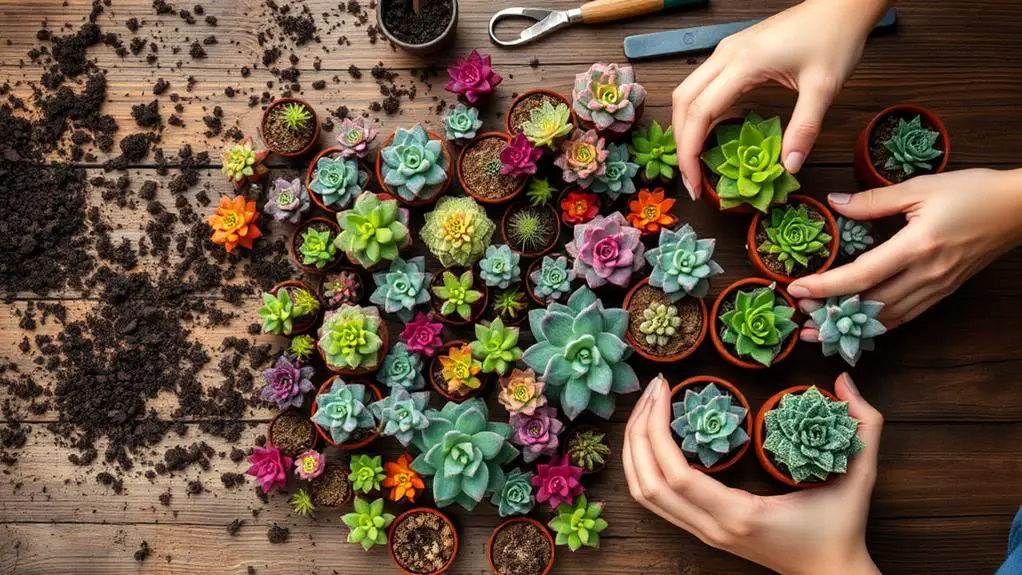
When selecting a new pot and revitalizing your succulent's home, it's just as important to avoid common mistakes that can hinder their growth.
Succulents are unique plants with specific needs, and understanding these will help you keep them healthy and happy. Here are some frequent errors to watch out for:
- Overwatering: This is the biggest mistake succulent owners make. Too much water leads to root rot, which can kill your plant. Make sure the soil is dry before watering again.
- Insufficient Light: Succulents need plenty of sunlight. Without enough light, they become weak and leggy. Place them in a bright spot, but avoid direct, scorching sun.
- Wrong Soil: Using regular potting soil can be harmful. Succulents need well-draining soil to prevent water retention and root problems. You can find special succulent soil at most garden centers.
- Ignoring Pests: Ants and other pests can cause major issues. Regularly check your plants for any signs of infestation. If you spot pests, act quickly to remove them.
Frequently Asked Questions
Can Dried Out Succulents Be Revived?
Yes, you can revive dried out succulents. Start by soaking the soil thoroughly, inspect the roots, and guarantee proper light and airflow. Avoid overwatering and let the soil dry between sessions. Healthy roots mean a good chance of recovery.
How to Bring a Succulent Plant Back to Life?
First, inspect the roots and remove any mushy parts. Let any broken leaves dry out. Replant in a well-draining pot and soil. Avoid watering for a few days. Confirm good sunlight and airflow. Monitor for pests.
Can You Break off Succulents and Replant?
Yes, you can break off succulents and replant them. Let the broken end dry for a few days, then plant in well-draining soil. Avoid watering immediately to promote healthy root growth and prevent rot.
How to Save an Uprooted Succulent?
First, inspect the roots for health. Let the uprooted succulent dry for 1-2 days. Replant in a pot with good drainage using well-draining soil. Avoid watering for another 1-2 days to help roots heal.
Conclusion
Don't worry about spilled succulents. It's a chance to grow your gardening skills and make your plants healthier. Check the roots, trim off any bad parts, and let them dry before replanting. Use well-draining soil and consider changing the pot if needed. With these steps, you'll see new growth and even get baby succulents. Mistakes happen, but they can lead to a thriving, beautiful collection. Keep at it—your succulents will thank you!

